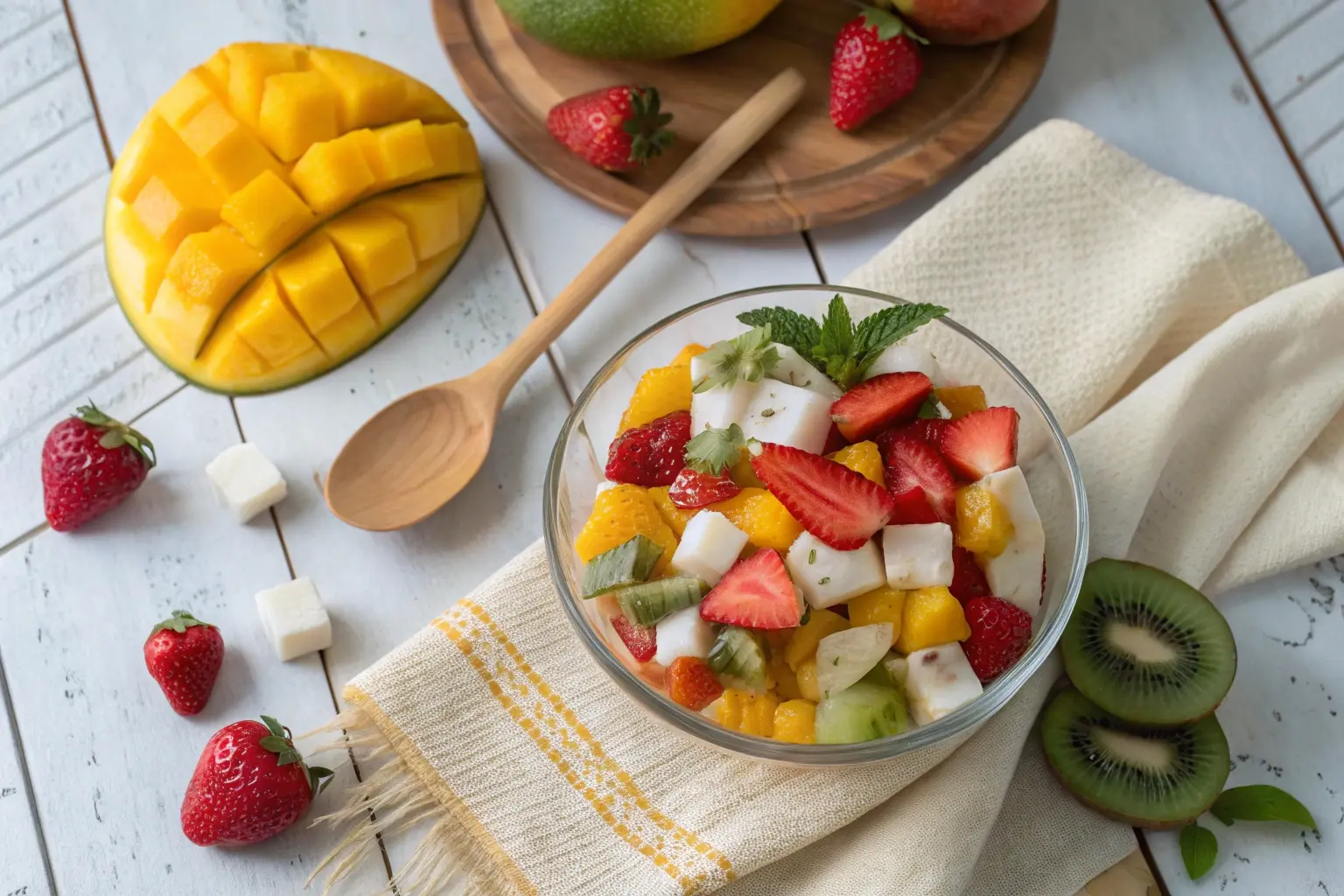If you’ve ever had nata de coco, you know it’s not just any coconut jelly—it’s a versatile treat that adds a delightful twist to both sweet and savory dishes. From tropical fruit salads to refreshing beverages, nata de coco offers a chewy texture and a subtle sweetness that makes it an exciting ingredient in countless recipes. But, what to eat nata de coco with? This article explores its unique pairing options, ranging from classic desserts to creative snacks, savory dishes, and beverages. Dive in to discover how this fascinating ingredient can elevate your meals!
Table of Contents
Introduction to Nata de Coco
What Is Nata de Coco?
Nata de coco is a jelly-like food made from the fermentation of coconut water. Its name, which means “cream of coconut” in Spanish, refers to the creamy layer formed during the fermentation process. Despite the name, nata de coco isn’t creamy—it’s chewy, slightly firm, and translucent. Its unique texture has made it a favorite in various cuisines, particularly in desserts and beverages.
Originating from the Philippines, nata de coco has gained popularity worldwide for its versatility. Whether served in fruit salads, bubble teas, or smoothies, its subtle sweetness and satisfying bite make it an appealing ingredient. But what to eat nata de coco with? Its neutral flavor means it can pair well with both sweet and savory dishes, making it a great addition to your kitchen repertoire.
How Is Nata de Coco Made?
The creation of nata de coco begins with fermenting coconut water using a bacterium called Acetobacter xylinum. This fermentation process produces a thick, gelatinous layer that is later harvested, washed, and cut into cubes. These cubes are typically soaked in syrup to enhance their flavor, though unsweetened versions are also available for those looking to reduce sugar intake.
This process not only gives nata de coco its chewy, jelly-like texture but also retains the nutritional benefits of coconut water, including dietary fiber and low-calorie content. Its light, refreshing quality is one reason why it’s such a popular ingredient in tropical and Asian-inspired dishes.
Why Is Nata de Coco Popular in Desserts?
What makes nata de coco a standout in desserts is its ability to complement and elevate other ingredients. Its chewy texture contrasts beautifully with soft fruits and creamy bases, adding a satisfying element to each bite. Additionally, its subtle sweetness means it doesn’t overpower other flavors, making it an ideal addition to everything from ice cream sundaes to parfaits.
When considering what to eat nata de coco with, think beyond the obvious. It’s a versatile ingredient that can be used in traditional recipes or as an unexpected twist in modern culinary creations. Its endless pairing options ensure that you’ll never run out of ideas to enjoy it.
Nata de Coco in Desserts
Classic Pairings: Fruit Salads and Ice Cream
When it comes to what to eat nata de coco with, fruit salads and ice cream are timeless choices. The chewy texture of nata de coco adds a delightful contrast to the softness of fresh fruits like mangoes, pineapples, and strawberries. Simply toss a handful of nata de coco into a bowl of diced fruits, drizzle some honey or condensed milk on top, and voilà—you’ve got a refreshing dessert!
Ice cream lovers can take it up a notch by using nata de coco as a topping. Whether it’s vanilla, mango, or coconut-flavored ice cream, the subtle sweetness of nata de coco blends perfectly. Plus, it gives your dessert a fun, chewy bite, making every spoonful a treat.
Tropical Delights: Mango Sago with Nata de Coco
One of the most beloved tropical desserts, mango sago, reaches new heights when combined with nata de coco. This Filipino-inspired dish features chilled mango puree, tapioca pearls, and fresh milk, topped off with cubes of nata de coco. Its vibrant flavors and contrasting textures create a tropical paradise in every bite.
Not only is mango sago easy to make, but the addition of nata de coco turns it into a showstopper. If you’ve been wondering what to eat nata de coco with, this creamy, fruity dessert should definitely be on your list.
Asian Inspirations: Bubble Tea and Nata de Coco
In bubble tea shops across Asia, nata de coco has become a popular alternative to tapioca pearls. Its crunchier texture and subtle coconut flavor make it a hit with boba enthusiasts. Whether it’s milk tea, fruit tea, or slushes, adding nata de coco creates a refreshing twist that keeps customers coming back for more.
Nata de Coco in Beverages
Blended Smoothies with Nata de Coco

When you’re craving a healthy yet satisfying drink, smoothies with nata de coco are the way to go. Blend frozen bananas, fresh mangoes, or strawberries with yogurt and a splash of coconut milk, then toss in some nata de coco cubes for texture. The jelly’s subtle sweetness and chewy bite transform a basic smoothie into a gourmet treat.
For extra flair, garnish your smoothie with shredded coconut or fresh mint leaves. If you’re ever pondering what to eat nata de coco with, smoothies offer endless customization options to suit any mood or craving.
Refreshing Juices with a Jelly Twist
Add a playful twist to your regular fruit juice by incorporating nata de coco. Orange, watermelon, or lychee juice pairs exceptionally well with this chewy jelly. Pour your juice over ice, stir in nata de coco, and enjoy a drink that’s both hydrating and satisfying.
This combo is particularly popular in tropical climates, where light, fruity drinks are a staple. Whether it’s a summer brunch or a midday refreshment, nata de coco brings an exciting texture to your beverage game.
How to Add Nata de Coco to Bubble Tea
If you’re a fan of bubble tea, you’ll love how nata de coco elevates this trendy drink. Start by preparing your favorite milk tea base or fruit tea blend. Then, instead of tapioca pearls, spoon in some nata de coco. The result? A light, fruity alternative that complements the creamy or citrusy notes of your tea.
Not only does nata de coco enhance the taste, but it also reduces the sugar load, making bubble tea a bit healthier. Next time you’re wondering what to eat nata de coco with, remember that it’s a perfect addition to your favorite drink.
Nata de Coco in Savory Dishes
Unique Salads with a Jelly Texture

While nata de coco is commonly associated with desserts, it’s also a surprising yet delightful addition to savory salads. Imagine a vibrant plate of mixed greens, sliced cucumbers, cherry tomatoes, and a drizzle of sesame dressing topped with chewy cubes of nata de coco. This ingredient provides a refreshing twist, adding both texture and a hint of sweetness that balances the tangy dressing.
For an Asian-inspired dish, try pairing nata de coco with shredded carrots, julienned bell peppers, and a sprinkle of crushed peanuts. This fusion of flavors and textures creates a unique salad that’s both light and satisfying.
Nata de Coco in Southeast Asian Cuisine
In Southeast Asia, creative chefs incorporate nata de coco into savory dishes to create a harmonious balance of flavors. It’s often used in cold noodle salads, where the jelly-like cubes pair beautifully with rice noodles, grilled shrimp, and a tangy lime-soy dressing. The result? A dish that’s not only refreshing but also packed with contrasting textures.
If you’ve been asking yourself, “What to eat nata de coco with?” consider exploring these lesser-known savory pairings. They showcase how versatile this coconut jelly can be, even in dishes that aren’t traditionally sweet.
Creative Snack Ideas with Nata de Coco
DIY Jelly Cups for Kids and Adults
Nata de coco shines in DIY jelly cups, making them a favorite snack for all ages. Start with a clear cup, layer fruit-flavored jelly, then add a spoonful of nata de coco. Repeat the layers with different-colored jellies to create a visually appealing, fun snack. Top it off with whipped cream or a sprinkle of rainbow sprinkles to make it extra festive.
These cups are not only quick to prepare but also perfect for parties or on-the-go treats. The combination of wobbly jelly and chewy nata de coco makes each bite an exciting experience.
Layered Parfaits with Fruits and Cream
Layered parfaits are another creative way to use nata de coco. Begin with a base of granola or crushed biscuits, add a layer of yogurt or whipped cream, and top it with nata de coco cubes and fresh fruit. Repeat the layers to create a stunning, delicious dessert in a glass.
Parfaits with nata de coco are a fantastic way to enjoy its chewy texture while experimenting with flavors. Whether you’re hosting brunch or simply treating yourself, these parfaits are sure to impress.
FAQs About Nata de Coco
Is Nata de Coco Healthy?
Yes, nata de coco is a healthy addition to your diet, especially when consumed in moderation. It’s naturally low in calories and fat, making it a great choice for weight-conscious eaters. Plus, it contains dietary fiber, which can aid digestion. However, some packaged versions are soaked in sugary syrups, so be sure to rinse or choose unsweetened options if you’re looking to cut back on sugar.
When exploring what to eat nata de coco with, consider pairing it with fresh fruits, yogurt, or unsweetened drinks to keep things nutritious yet flavorful.
What Fruits Pair Best with Nata de Coco?
Nata de coco pairs beautifully with a variety of fruits, enhancing both flavor and texture. Tropical fruits like mango, pineapple, and papaya complement its subtle sweetness. Citrus fruits like oranges and grapefruits add a zesty balance, while berries like strawberries and blueberries bring vibrant colors and tart flavors.
If you’re still wondering what to eat nata de coco with, experimenting with fruit combinations in salads or desserts is a great way to discover new favorites.
Can Nata de Coco Be Used in Savory Dishes?
Absolutely! While it’s popular in sweet dishes, nata de coco adds an interesting texture to savory salads and cold noodle dishes. Its mild flavor allows it to blend seamlessly with dressings and spices, making it a versatile ingredient for both sweet and savory recipes.
Conclusion: Versatility of Nata de Coco
Why Nata de Coco Fits Any Meal
From desserts to drinks and even savory dishes, nata de coco proves itself as a versatile ingredient. Its chewy texture and subtle sweetness make it an excellent addition to countless recipes, ensuring there’s always a creative way to enjoy it.
Experimenting with New Recipes
Now that you’ve discovered what to eat nata de coco with, the possibilities are endless. Whether you’re whipping up a fruit salad, crafting a bubble tea, or experimenting with savory creations, nata de coco is your go-to ingredient for adding fun and flavor to any dish. Get creative and enjoy the chewy goodness!

